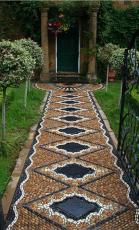Search
Login
Garden paths from natural stone, how to choose, we lay garden paths from natural stone correctly
Chinese folk wisdom says that all roads lead to those who built them. We can say with the same confidence that all roads and paths can tell a lot about their creators, especially if these are paths constructed by oneself on their own suburban area. They will talk about the ingenuity of the owners, their imagination, patience and ability to handle various natural and artificially created building materials.
Table of contents
- Materials used for paving garden paths video
- Laying a path made of natural stone, its advantages
- Garden paths made of natural granite stone video
- How to make an original path in the garden video
Materials used for paving garden paths

Making paths in the country or in the garden, you can use a wide variety of materials. For example: simple gravel, sandstone and limestone, granite, paving stones, multi-colored pebbles, using which you can achieve complex, beautiful patterns.
Today, natural stone paths are at a high level of popularity, because all the elements of their patterns are unique and diverse, have unique shapes and shades. The pattern is obtained due to the fact that the laying of natural stone is done by pressing it into the solution. Thus, the base is almost invisible, and the pattern stands out well in the brilliance of sunlight or the radiance of moonlight.

In order to build a walkway of natural stone with your own hands, you will not need much:
- natural natural stone (today often laying is done from colored pebbles),
- sketch of the pattern you want to reproduce
- cement mortar, sand, gravel,
- a little strength, patience and a certain amount of time.
Laying a path made of natural stone, its advantages

The paths in the garden, laid out with natural stone, can not be compared with everyone else. The difference between them is not only in the external charm, but also in the specifics of the styling, duration of use and strength (such tracks do not deform even under the weight of the car).
This is a fairly solid and reliable construction. They are not adversely affected by mechanical influences of various types.
The layout plan is as follows:
- prepared soil
- compressed sand bed,
- crushed stone bed
- layer that aligns all previous
- and, of course, the stone itself.
First of all, it is necessary to remove the fertile soil layer. Pour about 20 cm of sand into the next step. Then about 15 cm of gravel. The described technology will make it possible to make a solid and reliable garden path with one's own hand, which will not give in to deformation under loads or in bad weather conditions.

The following advantages of do-it-yourself stone paths should be noted:
- individuality of coating and external refinement;
- the opportunity to lay out a stone path with your own hands, without paying for the work of a team of special workers;
- long service life, reliability under various weather conditions, durability at high loads;
- the ability to not deform with sharp changes in temperature.
Here, as in everything, there are drawbacks:
- the price of colored pebbles is quite high;
- still have to spend it on what would bring it to your site;
- the need for a preliminary sketch of the desired drawing and its calculations;
- slow, laborious process of laying out a pattern.

Garden paths made of natural granite stone
Granite, one of the most durable and windproof materials, does not respond to high humidity and cold.

When paving paths with natural stone, you can use both granite and shungite, quartz, slate, sandstone. Granite has a very wide range of colors: from pale gray to red shades. Very often for paving paths they use chipped paving stones, boulders, flagstones and cobblestones. It is possible to try different options for combining shades, come up with an unusual pattern. Everything will depend only on your imagination.

Creating stone garden paths will require tools and materials such as:
- natural natural stone - sandstone, cobblestone, granite, river pebbles, shell rock, the choice of which depends on your ideas, capabilities and desires;
- the tool is chosen considering the state of the stone;
- cement mortar, wood blocks, gravel and sand;
- metal grid;
- shovel;
- wooden plank;
- master OK;
- for laying - a wooden hammer.
At the beginning of any work, some preparation is needed. But it should be noted that if you chose a material such as pebbles, then he does not need additional preparation, sorting by color and size is enough for him. Often, these procedures are done before hand-laying out patterns of pebbles.

In the process of working with cobblestone, flat slabs or wild stone, there is a need to chop some fragments or cut, in order to get the desired shape and size. To carry out these works, you may need different tools and devices.
Note that this work is quite lengthy and not simple. Many will prefer the purchase of an already prepared laying stone.
When arranging garden paths, it is advised to do the processing of the top layer of stone with substances that will protect and prevent them from cracking, possible with temperature changes. Processing should take place for the first time before installation, and subsequent - annually. Substances for stone processing are purchased in stores specializing in construction.
How to make an original path in the garden
Next, consider the options for paving paths with natural stone in your garden. Of course, this work can be done with your own hands, spending a certain amount of time and effort. First of all, you should choose what type of stone you will work with, then sketch a sketch of the future drawing.

Consider the order of work with wild stone on a sand and gravel base on sandy soils.

So, immediately prepare the ground. We mark along the side of the track with the help of pre-prepared wooden pegs and rope. We remove the growing weeds. Remove the topsoil. We sort the material selected for work, based on the data of the sketch. We do this as agreed earlier - in color and size. The next step is to fill the territory of the future track with a twenty-centimeter layer of sand. We ram. After that we put a fifteen-centimeter layer of gravel.

Next, we begin the most creative process. With our own hands we spread the stone in a layer of cement mortar. After the mosaic is assembled, we wipe all the formed seams between the stones with cement mortar and leave to dry.
To give greater rigidity and density to the stone garden path, you can strengthen it with reinforcement with a metal mesh. If you decide to do this, then the grid should be mounted in a cement mortar. Such reinforcement can be omitted if a large stone is selected for work. A similar method is mainly recommended for paving fairly wide paths, large areas, especially when there is an increased content of subsurface water in the soil.
Laying natural stone on a concrete base can be done in several ways.
- This method is used to create paths, parking areas and exit areas. Preparation consists in creating a layer of sand up to 10 cm thick. Sand is compacted densely. After laying the stones, the space between them is covered with the same cleaned sand.
- The second method is to lay the stone on a cement mortar, it is prepared in the proportion: 1 part cement to 5 parts sand.
- You can lay stone slabs directly on the ground. For this, a soil layer equal to half the thickness of the slab and corresponding in shape to it is pre-cut.

The basic rules that should be followed when creating a durable and reliable track:
- as a base, it is best to use a layer of compacted sand
- stones should be selected strong, hard rocks, for example - pebbles, dense sandstone, granite, cobblestone
- laying stones should leave gaps between them; they can be filled with soil and seeded with lawn grass, you can fill it with sand, to give a more decorative look, you can fill the gaps with a gravel backing that matches the color of the base material
- prolong the life of the stone path created by the rules of the drainage system: longitudinal and transverse
- to protect the bottom of the track from the germination of grass, you can apply a geotextile fabric.
Garden paths made of natural stone in your garden - this is a unique opportunity to unusual and colorful to give your landscape the desired features.

Although the natural stone for the tracks has a considerable price, the process of laying it will take time, especially if your ornaments are large and complex, believe me, the final result will exceed all your expectations and hopes. After completing all the work, you will receive a surprisingly beautiful, original canvas, distinguished by its strength and resistance to weather conditions.





